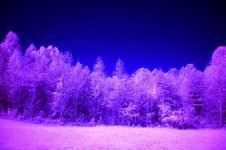excaliburken
New member
I know this may be an old subject, but I have a good way of fooling the D90 into an IR whitebalance. Since the traditional method never gained a GOOD preset, I took a photo that was taken with my D70 and put it on the D90's memory card. Since the D70 takes excellent IR WB presets, it worked for the D90 as well. A little longer shutter is required, but there is potential. Below is a sample image with the D90. I used an 18-55 lens ( set at 18mm) f/3.5 @ ISO 100 for 10 seconds on a tripod. All I did in PS was the simple Channel Mixer and adjusted the Levels just a little bit. Nothing major and no extensive time involved. No other Editing was done. There is hope.


